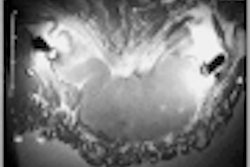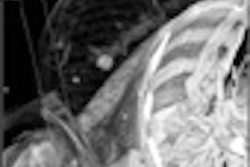The ability of CT to detect liver masses is dependent on the scanning technique used. Single or multislice, arterial or portal venous phase, contrast or noncontrast -- radiologists must consider all of these issues before devising an imaging strategy to pinpoint focal hepatic masses.
Dr. Rendon Nelson from Duke University in Durham, NC, outlined the protocols his group uses for hepatic CT at the International Symposium on Multidetector-Row CT, sponsored by Stanford University and held in San Francisco in June 2001.
"Our main job is the detection and characterization of the liver lesions," Nelson said. "Before we had helical CT, the big issue was speed. We’d scan as fast as we could. In the era of helical CT, things have gotten considerably more complicated."
Nelson began by discussing the various stages of lesion enhancement. Scanning in the early arterial phase is primarily useful for doing CT angiography, he said. The later arterial phase is better for lesion detection, particularly hypervascular lesions. In the longer portal venous phase and hepatic venous phase, hypovascular lesions are seen more easily. Scanning in the equilibrium phase should be avoided, as it may render many tumors invisible.
"The artery enhances starting around 15 seconds," Nelson said. "The arterial phase is relatively brief. The portal venous phase probably starts around 30 seconds, although the parenchyma doesn’t really enhance quite vividly. The equilibrium phase occurs roughly 2-3 minutes following the initiation of the bolus contrast material."
With regard to contrast material, the dose will affect the rate of scan delay, Nelson said.
"A lot of places, including our institution, are still using the higher volumes [of iodine] at 150 cc (45-gram dose) and starting at a rate of 3 cc/sec," he said. "With multislice CT, we can reduce that dose, but keep in mind that although arterial enhancement is predicated primarily on the timing of the bolus and the injection rate, the venous phase is predicated on the total iodine dose. If you cut your dose, you may be fine in the arterial phase, but you may reduce conspicuity in the venous phase."
Monophasic and biphasic scanning
When performing dynamic contrast-enhanced CT, the appearance of focal hepatic masses depends on the vascularity of the tumor, Nelson said. If scanning is performed during hepatic arterial perfusion, certain hypervascular tumors, such as focal nodular hyperplasia and endocrine tumors, will be hyperattenuating to the parenchyma. Many of these tumors will be invisible if imaged only during the phase when portal venous perfusion predominates.
Nelson suggested the following technical parameters for a monophasic CT scan during the portal venous perfusion phase:
- 125-150 cc of an ionic or nonionic contrast agent.
- Monophasic bolus injection at 2-3 cc/sec.
- Scan delay of 45 seconds for nonhelical CT with 5-mm collimation reconstructed at 8-10 mm intervals.
- Scan delay of 60-70 seconds for helical CT using a single detector row with 5-mm collimation, pitch=1.5:1, table speed of 1.5 mm/rotation, reconstruction at 5-7 mm intervals.
- For helical CT using multidetector row, 5-mm collimation, pitch=3.1, table speed of 15 mm/rotation, reconstruction at 5-7 mm intervals.
With spiral CT, investigators have the opportunity to perform rapid biphasic scanning through the entire liver, when both hepatic arterial perfusion and portal venous perfusion dominates, Nelson said.
For biphasic CT scanning in patients referred for evaluation of metastatic disease, Nelson recommended:
- 125-150 cc of a nonionic contrast agent.
- Monophasic injection at 4 cc/sec.
- Scan delay of 30 seconds for hepatic arterial phase; 65 seconds for portal venous phase.
- For helical CT using a single detector row, 5-mm collimation, pitch=2:1, table speed of 10 mm/rotation in the hepatic arterial phase; 5-mm collimation, pitch=1.5:1 in the portal venous phase; reconstruction at 5-7 mm intervals for both phases.
- For helical CT using a multidetector row, 5-mm collimation, pitch=2:1, table speed of 22.5 mm/rotation in the hepatic arterial phase; 5-mm collimation, pitch=3:1, table speed of 15 mm/rotation in the portal venous phase; reconstruction at 5-7 mm for both phases.
Cirrhosis
"In cirrhotic patients, we do a different protocol," Nelson explained. "We worry about these patients because we still know that we are missing a significant number of lesions." These patients may be suitable candidates for noncontrast CT, although the use of contrast material does improve sensitivity and results in an increased confidence in lesion detection, he added.
For biphasic CT scanning in patients with cirrhosis to evaluate for hepatocellular carcinoma, Nelson offered the following technical parameters:
- 150-175 cc of a nonionic contrast agent.
- Monophasic injection rate of 5 cc/sec.
- Scan delay of 30 seconds for hepatic arterial phase.
- Scan delay of 60 seconds for portal venous phase.
- For helical CT using a single detector row, 5-mm collimation, pitch=2:1, table speed of 10 mm/rotation in hepatic arterial phase; 5-mm collimation, pitch=6:1, table speed of 22.5 mm/rotation in portal venous phase; reconstruction at 5-7 mm for both phases.
While improvements in multislice CT are arriving fast and furious, Nelson cautioned against jumping on the technology bandwagon purely for the "wow" factor.
"There are some scanners out that that will do eight slices per rotation. But do we really need more than four-slice capability? The fundamental goal is to work toward high quality, large volume, reasonable radiation dose, and 3-D multiplanar images in a short or single breathhold," he said.
By Shalmali PalAuntMinnie.com staff writer
July 23, 2001
Related Reading
CT shows unique morphology of liver pseudolesions, May 10, 2001
CT and MRI aid successful management of fibrolamellar HCC, October 31, 2000
Copyright © 2001 AuntMinnie.com



















